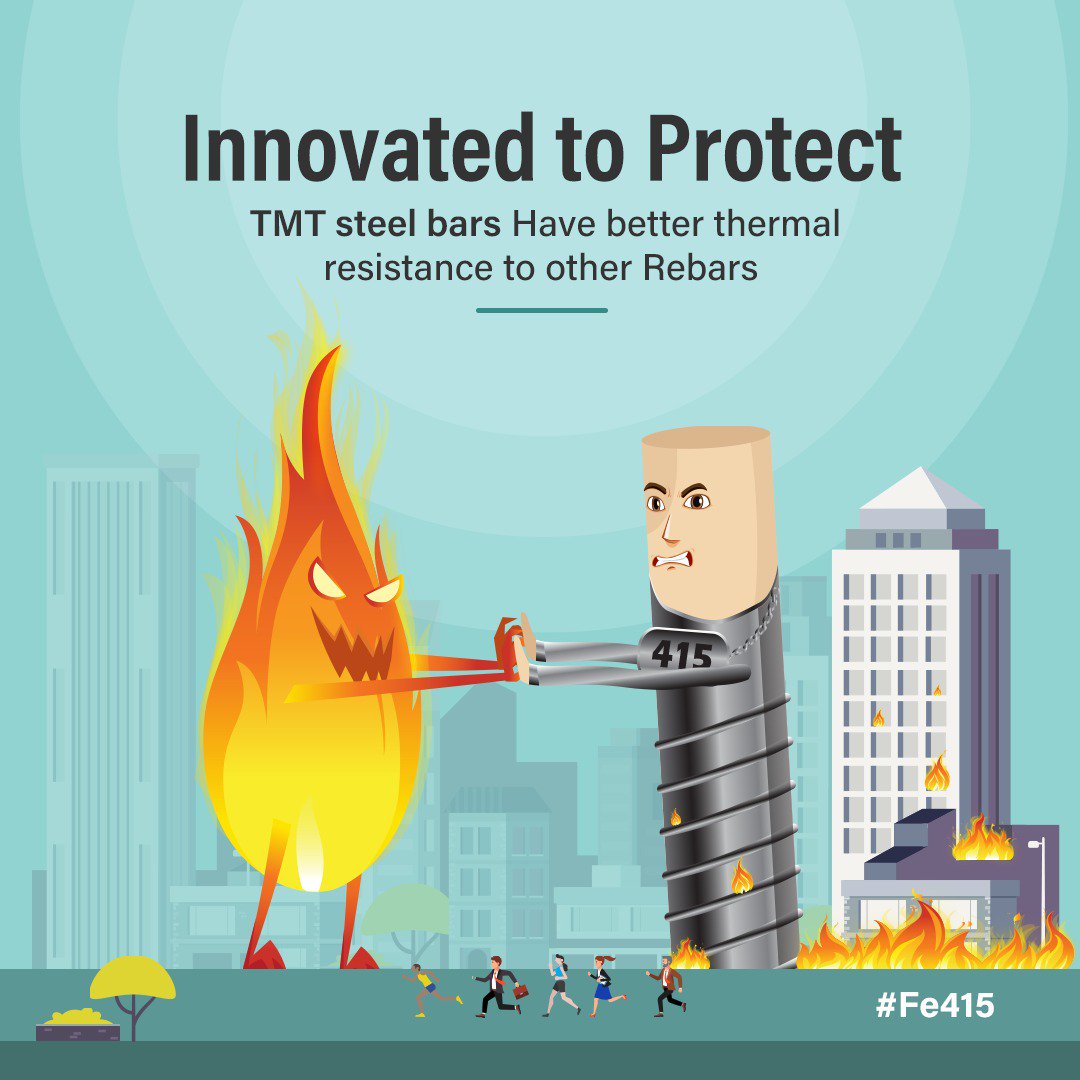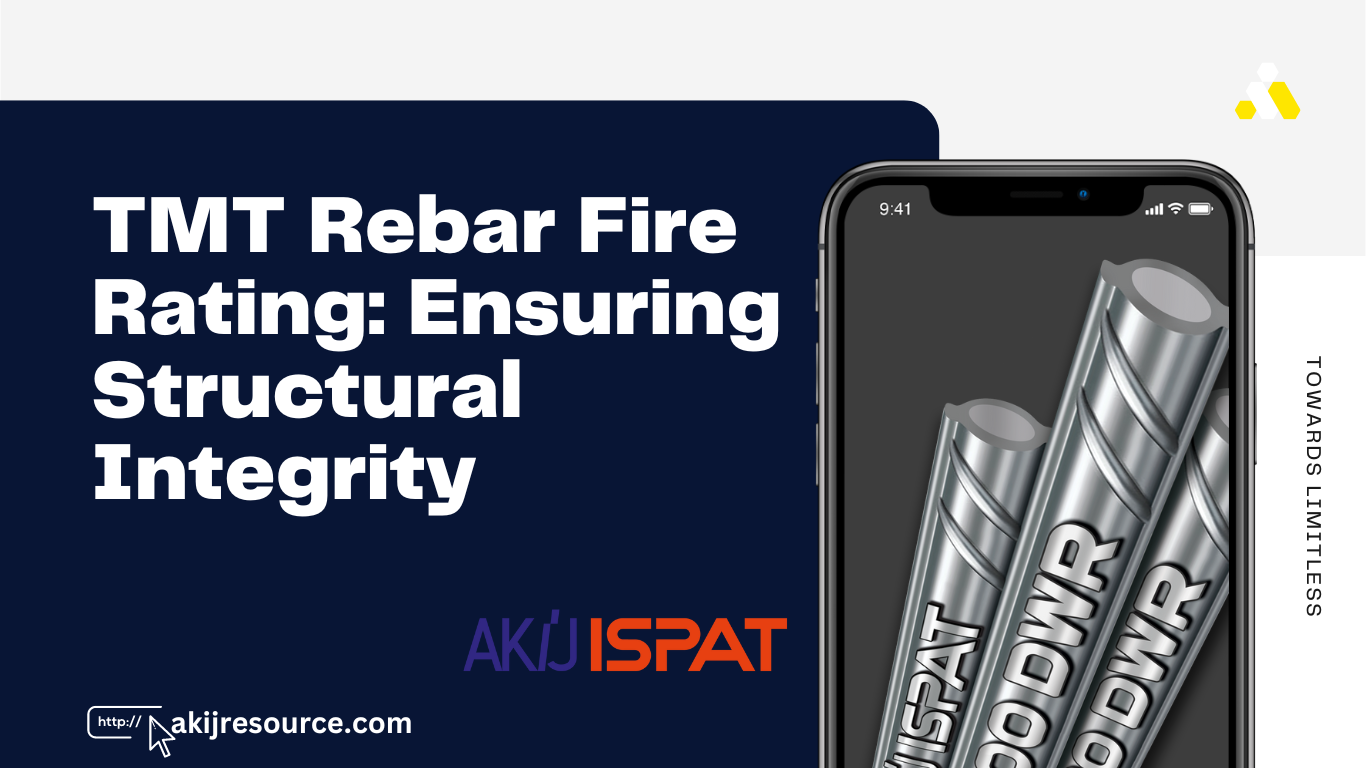TMT rebar boasts a fire rating of up to 600°C. This rating underscores its high thermal stability and safety in fire scenarios.
TMT (Thermo Mechanically Treated) rebar, a cornerstone in modern construction, brings unparalleled strength and durability to structures. Its exceptional fire resistance makes it a preferred choice for buildings requiring stringent safety measures against fire hazards. Not only does it support the structural integrity during extreme heat, but TMT rebar also contributes to the overall longevity of construction projects.
Its ability to withstand high temperatures without losing strength ensures that buildings remain safe and stable, even under dire conditions. This attribute is particularly crucial in areas prone to fire incidents, making TMT rebar an indispensable material in the construction industry. Its adoption reflects a commitment to safety, durability, and performance in contemporary building practices.

Credit: twitter.com
Introduction to TMT Rebar Fire Rating
Introduction to TMT Rebar Fire Rating dives deep into the resilience of TMT Rebar against fire. This aspect is crucial for buildings’ safety and longevity. TMT Rebar, known for its toughness, also boasts an impressive fire rating. This rating indicates how long TMT Rebar can withstand fire without losing its structural integrity. Understanding this rating helps in selecting the right rebar for construction projects.
Importance In Construction
- Ensures safety: High fire rating means more time for evacuation.
- Preserves structural integrity: Prevents collapse during fires.
- Compliance with regulations: Meets building codes and standards.
- Long-term durability: Resists fire damage, prolonging building life.
Basics Of Fire Rating
The fire rating of TMT Rebar is measured in hours. It reflects the duration TMT Rebar can resist fire. Higher ratings indicate better performance under fire. The rating is determined through standard testing methods. These tests expose TMT Rebar to extreme heat, assessing its structural performance.
| Rating (Hours) | Performance |
|---|---|
| 1-2 | Basic protection |
| 2-4 | Intermediate protection |
| 4+ | Advanced protection |
Selecting TMT Rebar with an appropriate fire rating is essential. It ensures the structure’s safety and compliance with building codes. This selection impacts the overall resilience of buildings against fire.
TMT Rebar Composition
Thermo-Mechanically Treated (TMT) rebars are essential in construction. They provide support and strength to structures. Understanding their composition is key. This includes core materials and protective coatings.
Core Materials
The core of TMT rebars consists of high-strength steel. This steel comes from combining several elements:
- Iron: The base of the rebar material.
- Carbon: Adds hardness to the steel.
- Manganese: Improves strength and ductility.
- Sulphur and Phosphorus: Controlled to prevent brittleness.
The precise mixture ensures a tough inner core. This core can withstand high temperatures.
Protective Coatings
Besides the strong core, TMT rebars have a unique coating. This coating protects them from fire and corrosion:
| Coating Type | Benefits |
|---|---|
| Epoxy Coating | Resists corrosion, strong bond with concrete. |
| Zinc Coating | Galvanizes rebar, provides sacrificial layer. |
Such coatings ensure the rebars maintain integrity during fires. They help in preserving the structure’s stability.
How Fire Affects Rebar
Understanding how fire impacts Tmt Rebar is crucial for building safety. In a fire, the strength and stability of reinforced concrete can change. Let’s explore the effects of high temperatures on Tmt Rebar.
Temperature Thresholds
Tmt Rebar has specific temperature limits. Beyond these, its properties change. Here’s what happens at different heat levels:
- 212°F (100°C): Water in concrete evaporates.
- 932°F (500°C): Rebar strength starts to decline.
- 1,112°F (600°C): Significant loss in strength occurs.
These thresholds show how critical temperature control is for rebar’s integrity.
Structural Implications
When exposed to fire, TMT Rebar’s role in concrete is compromised. The outcomes can be serious:
| Temperature | Effect on Rebar | Structural Impact |
|---|---|---|
| 212 – 932°F | Strength reduction | Decreased load capacity |
| Above 932°F | Rapid strength loss | Potential structural failure |
Builders must consider these effects to ensure structures can withstand fire.
Fire Rating Standards For Rebars
Understanding the fire rating of TMT rebars is crucial. It ensures safety in structures during fire events. These standards measure how rebars withstand high temperatures. Let’s delve into the fire rating standards that govern the performance of rebars globally.
International Codes
Various international codes define rebar fire ratings. These include the Eurocode 2, ASTM E119, and ISO 834. They set benchmarks for rebars’ fire resistance. Builders and engineers worldwide rely on these standards. They ensure construction materials meet safety requirements.
- Eurocode 2: Focuses on concrete structures.
- ASTM E119: Covers fire tests for building materials.
- ISO 834: Details the fire resistance tests.
Testing Procedures
Rebars undergo rigorous testing to receive a fire rating. The procedures simulate extreme heat conditions. Experts measure the rebars’ structural integrity during these tests.
- Heat the rebar to specific temperatures.
- Hold the temperature for a set duration.
- Assess the rebar’s performance under stress.
Accurate testing ensures that TMT rebars can be trusted. They provide essential support during fires. With proper testing, buildings stand strong against heat.
Enhancing Tmt Rebar Fire Resistance
Enhancing TMT Rebar Fire Resistance plays a crucial role in constructing safer buildings. TMT, or Thermo-Mechanically Treated bars, are widely used for their strength and flexibility. Yet, their fire resistance can be a concern. Let’s explore how innovative practices and protective measures can improve TMT rebar’s performance in fire conditions.
Innovative Manufacturing Processes
New manufacturing techniques are vital for better fire-resistant TMT bars. These processes strengthen the rebar’s core and ensure a tougher surface. They involve quenching and self-tempering which create a strong outer layer. This layer acts as a shield during fire, protecting the core. The advanced processes result in rebars that maintain integrity even at high temperatures.
Additional Protective Measures
Besides manufacturing advancements, additional measures can protect TMT bars in fires. Applying fireproof coatings is one approach. These coatings expand when exposed to heat, forming an insulating layer. This layer keeps the temperature of the rebar lower, delaying any loss of strength. Another method is encasing the rebars in concrete with high fire resistance. This not only protects the rebar but also enhances the overall fire rating of the structure.
Regular testing is also part of these measures. It ensures that the rebars meet the necessary safety standards. Each batch of TMT bars undergoes rigorous fire resistance tests. These tests simulate extreme conditions to guarantee performance during an actual fire event.
- Fireproof Coatings: Create an insulating barrier on rebars.
- Concrete Encasement: Shields rebars and improves structure’s fire rating.
- Continuous Testing: Certifies the rebars’ performance under fire.

Credit: yklsteel.en.made-in-china.com
Case Studies
Exploring how TMT Rebar stands up to fire is crucial. We look at real incidents. This shows us how TMT Rebar reacts in extreme conditions.
Real-world Fires
- Building Collapse in Mumbai, 2018: A fire broke out. TMT Rebar in the structure held up, preventing total collapse.
- Mall Fire in Delhi, 2019: Despite the blaze, the building’s frame, reinforced with TMT Rebar, remained intact.
Performance Analysis
We analyze TMT Rebar’s response to high temperatures in these cases.
| Event | Temperature | Performance |
|---|---|---|
| Mumbai Building | 1000°C | Stable |
| Delhi Mall | 1200°C | Intact |
In both events, TMT Rebar helped save structures from total loss.
Installation And Maintenance
Understanding the installation and maintenance of TMT rebar is crucial. This ensures long-lasting fire resistance. Let’s explore proper techniques and tips for optimal performance.
Proper Installation Techniques
Correct installation of TMT rebar is vital for fire safety. Follow these steps for best results:
- Check building codes: Ensure compliance with local regulations.
- Use appropriate tools: This guarantees secure fitting.
- Align rebars correctly: Proper alignment prevents structural weaknesses.
- Ensure adequate coverage: Concrete must fully cover rebars for protection.
- Inspect placement: Verify spacing and positioning before concrete pour.
Regular Maintenance Tips
Maintenance is key to preserving TMT rebar’s fire rating. Implement these tips routinely:
- Perform inspections: Look for signs of corrosion or damage.
- Clean regularly: Remove debris to prevent rust.
- Monitor moisture: Keep the area dry to avoid corrosion.
- Apply protective coatings: These can enhance fire resistance.
- Replace if needed: Swap out compromised rebars to maintain integrity.
Future Of Fireproofing In Construction
The future of fireproofing in construction is vital. Builders seek materials that can withstand high temperatures. TMT Rebar is a popular choice. Its fire rating makes it a key player in safe building practices.
Emerging Technologies
Innovations in fire safety are transforming construction. New materials resist heat better than ever. Smart systems detect and prevent fires. This progress ensures buildings stay strong in extreme heat.
- Intumescent coatings swell when hot, protecting steel structures.
- Fire-resistant polymers form a char layer, shielding the rebar.
- Smart sensors monitor temperature changes, triggering safety measures.
Sustainable Practices
Sustainability shapes fireproofing methods. Eco-friendly materials are in demand. They offer strong fire resistance with less environmental impact.
| Material | Benefits |
|---|---|
| Recycled TMT Rebar | Reduces waste, saves energy |
| Non-toxic Fire Retardants | Safe for the environment, effective |
| Green Insulation | Conserves energy, fire-resistant |
These practices not only protect structures. They also preserve our planet.
Frequently Asked Questions
What Is The Fire Resistance Of Tmt?
TMT bars possess high thermal stability, enduring temperatures ranging from 400°C to 600°C, which contributes to their effective fire resistance.
What Are The Grades Of Tmt Rebar?
TMT rebar grades typically include Fe 415, Fe 500, Fe 550, Fe 600, and their ductile versions like Fe 500D and Fe 550D.
What Is The Difference Between Tmt Bar And Tmt Rebar?
TMT bar and TMT rebar refer to the same product; “rebar” is short for reinforcing bar. Both terms describe high-strength steel bars used in reinforcing concrete structures. They ensure durability and support in construction projects. No difference exists between them; it’s purely a matter of terminology preference.
What Is 600 Tmt Mean?
“600 TMT” stands for 600 thousand metric tons, a unit of measure commonly used in industries like shipping and commodities to quantify large quantities of materials or products.
Conclusion
Understanding the fire rating of TMT rebar is crucial for safe construction. With its high resistance to extreme temperatures, TMT rebar offers peace of mind in building design. It’s a smart choice for durability and safety. Remember, choosing the right materials can make all the difference in fire prevention and structural integrity. When considering TMT rebar for construction, it’s important to also adhere to rebar spacing guidelines to ensure proper reinforcement in the event of a fire. Following these guidelines can help maximize the effectiveness of TMT rebar in maintaining the structural integrity of a building during a fire. By understanding the fire rating of TMT rebar and adhering to rebar spacing guidelines, construction projects can enhance safety and longevity.
Make an informed decision for your next project with TMT rebar’s reliable performance.






















